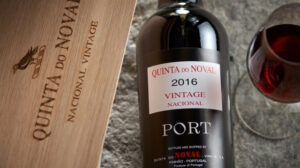Almost any discussion of “ultimate wine places” can bring a multitude of counter-arguments, but when the conversation gets to the top sweet reds things get very simple. The Douro Valley is breathtaking not only for the beauty of its vineyards – which are of course recognised as a World Heritage Site by Unesco – but also for the unsurpassed performance of its fortified reds, which come from a 3-digit(!) number of Indigenous, rare varieties.
At the top of the hierarchy of the world’s strongest wines – whose alcohol ranges from 19.5 to 20.5% – are the terrifyingly concentrated and structured Vintage Ports, which always come from a single vintage, but rarely from a single vineyard. The brightest, single vineyard exception among them, is the fabulous Quinta do Noval Nacional.
The blessed vineyard of the Douro
The estates (Quinta) that exist in the Douro vineyard with its frightening temperature differences are countless, and Quinta do Noval is among the top of the top. References to it date back to the early 17th century, but the road to the top opened wide in 1894 with its purchase by Antonio Jose da Silva.
The source of the splendor is the 1,920-hectare vineyard, which starts at 100 metres and reaches 500, while the plots that make up the vineyard look out to all four points of the horizon. But even more impressive is the fact that despite its immense size, it is classified as a Class A vineyard, the top level in the 6-point official ranking system created in 1757!
The region was one of the first to be completely destroyed when phylloxera hit Europe just before the advent of the 20th century, with all of its vineyards – Quinta do Noval included – replanted on disease-resistant American rootstock. All of them? Not quite, since a small 20-acre patch just below the estate’s farmhouse miraculously never got sick. So even today all of its vines – ranging from 40 to 80 years old – are native and naturally planted with native grapes, making it a unique monument of national (Nacional!) heritage and pride.
The basic variety of Port is called Touringa Nacional, but despite its name, Nacional is not only derived from it but also from other great grapes such as Touringa Franca, Tinta Roriz, Tinta Cao, and Sousao. Another peculiarity of this special piece, with its northeastern orientation, is the frighteningly low yields since the sandy climates can only offer more than 12hl/ha! Hence simple mathematics easily explains its designation as the “Holy Grail” of Port, since the average annual quantity is only 200-250 cases.
Moreover, its production delivers lessons in perfectionism, with the grapes being traditionally pressed by foot in concrete Lagares – as this old-school method is considered unsurpassed in its ability to squeeze out all the power of the roses without imparting excessive and/or bitter tannins to the must – and ripening taking place in large 2,500-litre vats of oak and chestnut.
Needless to say, a major part of this perfection is the fact that it is only produced in the best years, with only 34 having been released since the maiden 1931! This 2ha piece is so unique that it can drive Nacional to perfect maturity when all other top pieces fail to do so, but it also fails to make the vines “sing” even in a universally excellent year. Thus, there are years when the equally great Quinta do Noval Vintage was released but not the Vintage Nacional and vice versa!
All Port results from stopping fermentation by adding alcohol and fortifying the wine to the 20-degree level. The Nacional measures 19.5 and about 85gr/lt of residual sugars, but its awesome power doesn’t come from these numbers – after all, all wines of this genre “count” up or down that much. It comes from the awesome concentration of fresh fruit expressed in every possible …black form (blackberries, plum, blackcurrant) spiced with sweet spices, mint, herbs and wet leaves and the impressive quantity and quality of tannins, elements that allow it to wander perpetually through time.
The 40-year aging potential is the norm rather than the exception for every vintage of Nacional, and this virtue comes to add even more value to the already unattainable prices of this great wine. After all, even recent vintages of Nacional go for over €1,000, while old bottles can go for 5 times that amount! And if you think that because you’re getting a lot you’ll get a better price you’re sadly mistaken, as Sotheby’s in 2018 sold a case of the famous 1963 for £45,980 (plus commission and VAT)!
Nature’s miracles may be many, but a miracle of this level – where a tiny piece of land was left unscathed amongst millions of acres of destroyed vineyards – is particularly rare. And equally rare is its result, with Quinta do Noval Nacional Vintage Port being not only one of the greatest wines on the planet but also the wine guardian of an entire nation.
Ask me anything
Explore related questions





